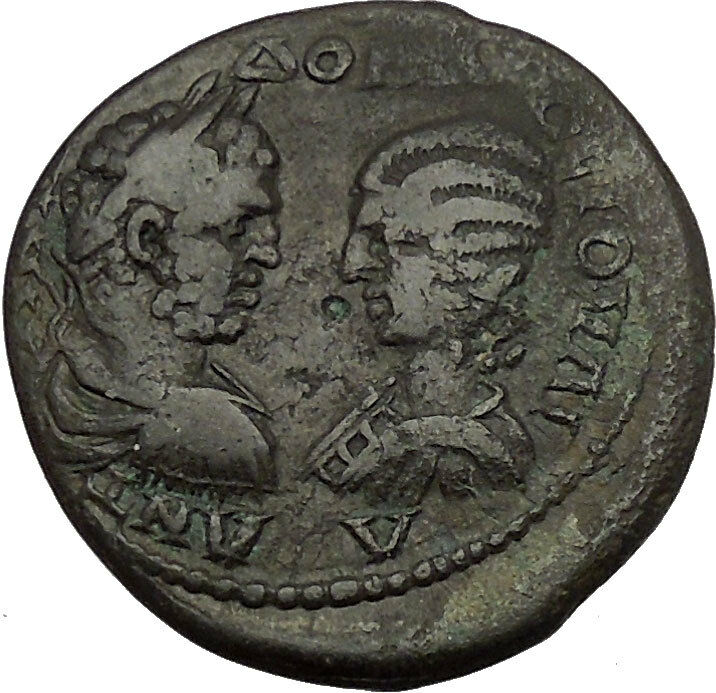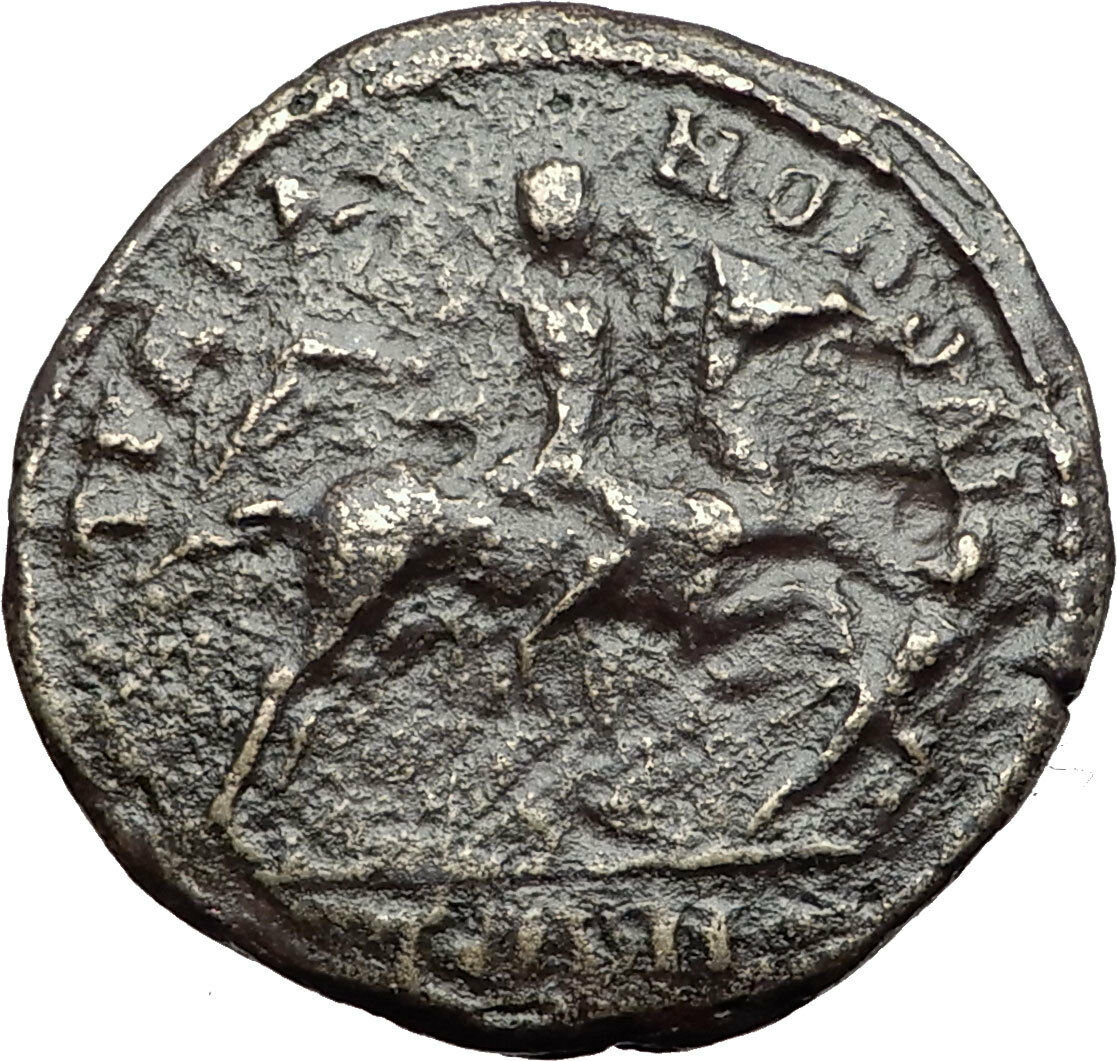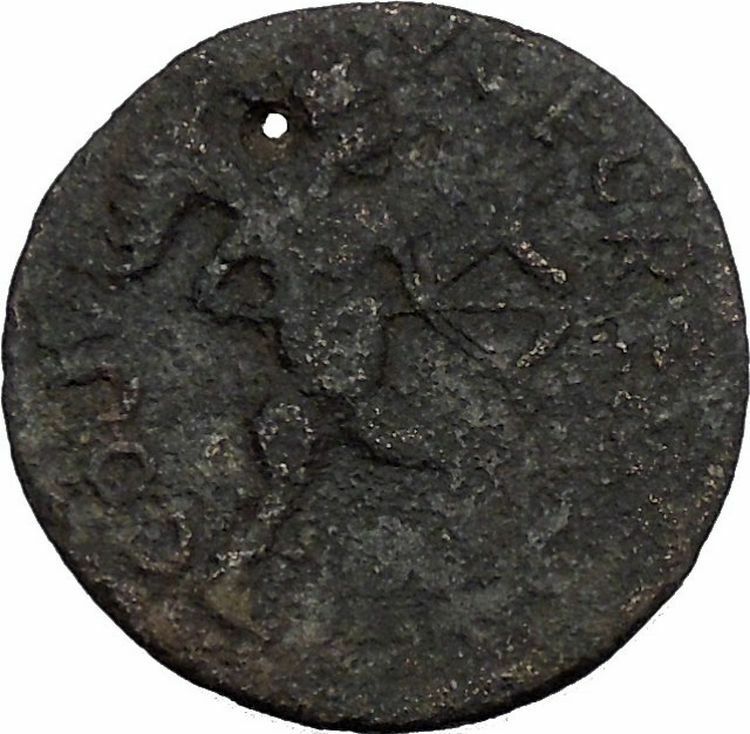|
Caracalla – Roman Emperor: 198-217 A.D. –
Bronze 28mm (10.28 grams) of Anchialus in Thrace
AVP M AVP KA ANTΩNINOC, laureate, draped, cuirassed bust right.
OVΛПIANΩN AΓXIAΛEΩN, Eagle, standing on winged thunderbolt of Zeus facing, wings open, head left, wreath in beak
You are bidding on the exact item pictured, provided with a Certificate of Authenticity and Lifetime Guarantee of Authenticity.
A cape is any sleeveless outer garment , such as a poncho , but usually it is a long garment that covers only the back half of the wearer, fastening around the neck.
Capes were common in medieval Europe , especially when combined with a hood in the chaperon , and have had periodic returns to fashion , for example, in nineteenth century Europe. Roman Catholic clergy wear a type of cape known as a ferraiolo , which is worn for formal events outside of a liturgical context. The cope is a liturgical vestment in the form of a cape. Capes are often highly decorated with elaborate embroidery. Capes remain in regular use as rain wear in various military units and police forces, for example in France. A gas cape was a voluminous military garment designed to give rain protection to someone wearing the bulky gas masks used in twentieth century wars.
In fashion, the word cape usually refers to a shorter garment and cloak to a full-length version of the different types of garment, though the two terms are sometimes used synonymously for full-length coverings. The fashion cape does not cover the front to any appreciable degree. In raingear, a cape is usually a long and roomy protective garment worn to keep one dry in the rain.
In full evening dress , ladies frequently use the cape as a fashion statement , or to protect the wearer or the fine fabrics of their evening-wear from the elements, especially where a coat would crush—or hide—the garment. These capes may be short (over the shoulders or to the waist) or a full-length cloak. Short capes were usually made of, or trimmed in, fur; however, because fur is less accepted as a fashion accessory in modern times, other expensive materials are substituted for it, with an opulent lining and trim. Typical fabrics used are velvet , silk and satin . Capes are still authorized as an alternative to the more utilitarian trench coat for U.S. Army officers in mess dress , formal evening uniform.
Caped overcoats were popular for men during the Victorian era, with some caped Ulsters featuring multiple layered capes, and the Inverness coat (both formal evening and working day variants) had a cape.The Inverness coat is no longer commonly worn, and the Ulster lost its cape in the 1920s.
In modern times, comic book superheroes , such as Superman , Batman , and Thor are often described as wearing “capes” or “opera capes”, although most of these are long enough to count as opera cloaks .
Antoninus (Called ‘Caracalla’)
 Caesar: 195-198 A.D. Caesar: 195-198 A.D.
Augustus: 198-217 A.D.
( 198-209 A.D. – with Septimius Severus)
( 209-211 A.D. – with Septimius Severus and Geta)
( 211-217 A.D. – Sole Reign)
Caracalla (April 4, 188 – April 8 , 217. Caracallus ), born Lucius Septimius Bassianus and later called Marcus Aurelius Antoninus and Marcus Aurelius Severus Antoninus, was the eldest son of Septimius Severus and Roman Emperor from 211 to 217. He was one of the most nefarious of Roman emperors. Caracalla’s reign was notable for:
-
the Constitutio Antoniniana , granting Roman citizenship to freemen throughout the Roman Empire , according to Cassius Dio in order to increase taxation;
-
debasing the silver content in Roman coinage by 25 percent in order to pay the legions; and
-
the construction of a large thermae outside Rome, the remains of which, known as the Baths of Caracalla , can still be seen today
“Caracalla was the common enemy of all mankind,” wrote Edward Gibbon . He spent his reign traveling from province to province so that each could experience his “rapine and cruelty.”
Caracalla’s real name was Marcus Aurelius Antoninus. He got the nickname from his habit of wearing a cloak by the same name. Caracalla was the elder son of Septimius Severus and brother of Geta whom he positively hated. Hated so much, in fact, that he had him murdered a few years later. In the mayhem that followed, Caracalla’s men went on a killing spree of anyone suspected of being a Geta sympathizer. In the massacre, it’s estimated up to 20,000 people lost their lives. Caracalla would go on to rule for another five years but his bad karma caught up with him and he was assassinated in a plot perpetrated by Macrinus.
As an emperor Caracalla possessed few redeeming qualities and among the worst of them would be his ruinous drain on the treasury. Because he knew everyone hated him he sought the protection of the army. And the surest way of getting this protection was to buy it outright. He raised the pay of the solider to about four denarii per day, nearly quadrupling the salary of just a few years prior. And on top of their regular salary he heaped endless bonuses and other concessions meant to endear them. This money could only have come by the oppressive taxation of ordinary citizens as well as the seizures of property of the wealthy under trumped-up charges. This not only intensified the hatred against him but also had the effect of corrupting the military who had become accustomed to this life of luxury and throwing the economy into lasting disarray.
Rise to power
Caracalla, of mixed Punic /Berber and Syrian Arab descent, was born Lucius Septimius Bassianus in Lugdunum , Gaul (now Lyon, France ), the son of the later Emperor Septimius Severus and Julia Domna . At the age of seven, his name was changed to Marcus Aurelius Septimius Bassianus Antoninus to solidify connection to the family of Marcus Aurelius . He was later given the Caracalla nickname , which referred to the Gallic hooded tunic he habitually wore and which he made fashionable.
His father, who had taken the imperial throne in 193, died in 211 while touring the northern marches at Eboracum (York), and Caracalla was proclaimed co-emperor with his brother Publius Septimius Antoninius Geta . However since both of them wanted to be the sole ruler, tensions between the brothers were evident in the few months they ruled the empire together (they even considered dividing the empire in two, but were persuaded not to do so by their mother). In December 211, Caracalla had Geta, the family of his former father-in-law Gaius Fulvius Plautianus , his wife Fulvia Plautilla (also his paternal second cousin), and her brother assassinated. He persecuted Geta’s supporters and ordered a damnatio memoriae by the Senate against his brother.
Reign
In 213 Caracalla went north to the German frontier to deal with the Alamanni who were causing trouble in the Agri Decumates . The emperor managed to win the sympathy of the soldiers with generous pay rises and popular gestures, like marching on foot among the ordinary soldiers, eating the same food, and even grinding his own flour with them.
Caracalla defeated the Alamanni in a battle near the river Main, but failed to win a decisive victory over them. After a peace agreement was brokered, the senate conferred upon him the title “Germanicus Maximus”. In the next year the emperor traveled to the East.
When the inhabitants of Alexandria heard Caracalla’s claims that he had killed Geta in self-defense, they produced a satire mocking this claim, as well as Caracalla’s other pretensions. Caracalla responded to this insult savagely in 215 by slaughtering the deputation of leading citizens who had unsuspectingly assembled before the city to greet his arrival, and then unleashed his troops for several days of looting and plunder in Alexandria. According to historian Cassius Dio, over 20,000 people were killed.
During his reign as emperor, Caracalla raised the annual pay of an average legionary to 675 denarii and lavished many benefits on the army which he both feared and admired, as instructed by his father Septimius Severus who had told him to always mind the soldiers and ignore everyone else. His official portraiture marked a break with the detached images of the philosopher-emperors who preceded him: his close-cropped haircut is that of a soldier, his pugnacious scowl a realistic and threatening presence. The rugged soldier-emperor iconic type was adopted by several of the following emperors who depended on the support of the legions, like Trebonianus Gallus .[11]
Seeking to secure his own legacy, Caracalla also commissioned one of Rome’s last major architectural achievements, the Baths of Caracalla , the largest public bath ever built in ancient Rome. The main room of the baths was larger than St. Peter’s Basilica , and could easily accommodate over 2,000 Roman citizens at one time. The bath house opened in 216, complete with private rooms and outdoor tracks. Internally it was decorated with golden trim and mosaics.

The Roman Empire and its provinces in 210 AD
Fall
While travelling from Edessa to begin a war with Parthia , he was assassinated while urinating at a roadside near Harran on April 8 , 217 by Julius Martialis, an officer in the imperial bodyguard. Herodian says that Martialis’ brother had been executed a few days earlier by Caracalla on an unproven charge; Cassius Dio, on the other hand, says that Martialis was resentful at not being promoted to the rank of centurion. The escort of the emperor gave him privacy to relieve himself, and Martialis ran forward and killed Caracalla with a single sword stroke. He immediately fled on horseback, but was killed by a bodyguard archer.[ neededcitation]
Caracalla was succeeded by the Praetorian Prefect of the Guard, Macrinus , who almost certainly was part of the conspiracy against the emperor.
His nickname
According to Aurelius Victor in his Epitome de Caesaribus, the cognomen “Caracalla” refers to a Gallic cloak that Caracalla adopted as a personal fashion, which spread to his army and his court. Cassius Dio and the Historia Augusta [14] agree that his nickname derived from his cloak, but do not mention its country of origin.

Caracalla and Geta by Lawrence Alma-Tadema . 1907.
Legendary king of Britain
Geoffrey of Monmouth ‘s legendary History of the Kings of Britain makes Caracalla a king of Britain, referring to him by his actual name “Bassianus”, rather than the nickname Caracalla. After Severus’s death, the Romans wanted to make Geta king of Britain, but the Britons preferred Bassianus because he had a British mother. The two brothers fought a battle in which Geta was killed, and Bassianus succeeded to the throne. He ruled until he was betrayed by his Pictish allies and overthrown by Carausius , who, according to Geoffrey, was a Briton, rather than the Menapian Gaul that he actually was.
|





 Caesar: 195-198 A.D.
Caesar: 195-198 A.D.




